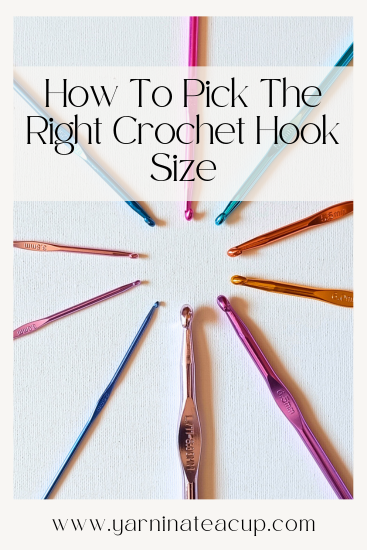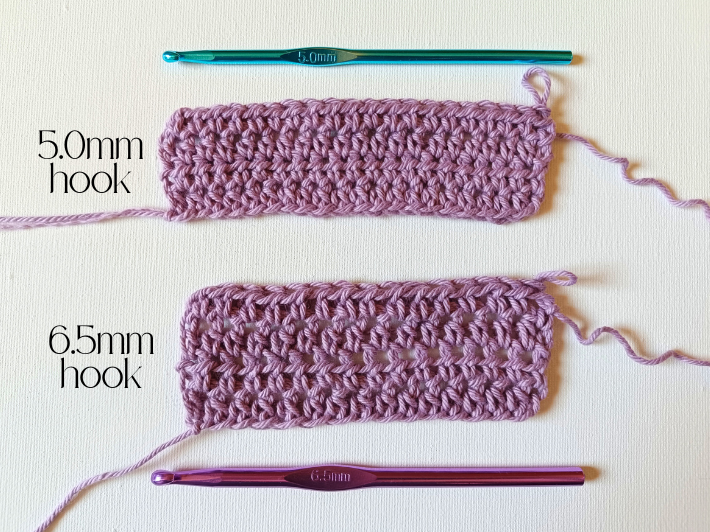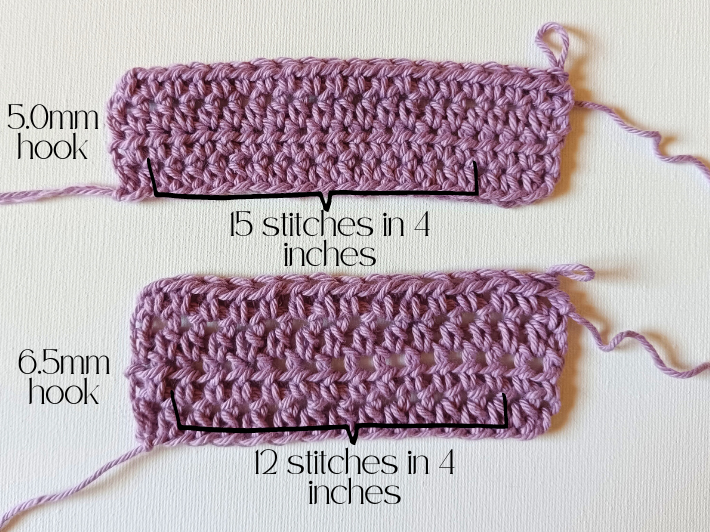
Recently, I was on Instagram scrolling through crochet videos. I watched as a beginner crocheter showed a picture of the amigurumi they were trying to make, and then the wonky amigurumi they actually crocheted. It makes for a funny video, but it’s so frustrating when a crochet project doesn’t turn out the way it’s supposed to! The crochet hook size you use plays a huge role in how your finished project turns out, so it’s important to pick the right one.
Generally, you should use the crochet hook size listed in the pattern you’re using. The exception to this is when you’re using a different yarn than the pattern, the pattern does not specify what yarn and/or hook size to use, or if you crochet with an atypical tension. Then, you should either use the hook size listed on your yarn’s label or experiment with different hooks until you match your crochet pattern’s gauge.
This article is meant for advanced beginner crocheters who have a few projects under their belt. If you’ve just started crocheting, I suggest reading this article about the best size crochet hook for beginners.
Why Does Hook Size Matter?
The size of the crochet hook you use is super important and affects all aspects of your crocheting. First, the crochet hook needs to match the weight of the yarn you’re using. If your hook is too small, you won’t be able to catch the yarn with your hook to yarn over, or keep the yarn on your hook. On the other hand, it’s hard to chain and insert your hook into stitches with a crochet hook that’s too big. There’s a specific range of hook sizes that work well with each yarn weight, letting you comfortably crochet and create consistent, even stitches.
The crochet hook you use will also determine the size and structure of your finished project. If you use a crochet hook on the smaller end of the range, the smaller the stitches will be and vice versa. Smaller stitches are more compact and will result in a tighter weave that holds its shape, while bigger stitches create a looser weave and a more flexible fabric. This means that you can use the same yarn as a crochet pattern, but if you use a different sized crochet hook, the finished product can turn out much differently.

*The 5.0mm swatch is 20 stitches wide, and the 6.5mm swatch is 15 stitches wide. They’re both 4 rows tall.
Crochet Hook Size and Yarn Weight Chart
This chart uses information from the Yarn Craft Council. It’s important to know that there’s no strict rules that companies follow to label their yarn. Dk weight yarns in particular can be totally different sizes depending on who’s producing them. Keep that in mind when you use the chart, and remember these are guidelines and not ironclad rules.
When you’re choosing your hook size, think if the finished object should have a stiff fabric that keeps its shape, or a lighter, more flexible fabric. Amigurumi need a tight fabric to keep in the stuffing, so you should choose a hook size on the small end of the range. Shawls are generally lacy with a lot of drape, therefore a bigger hook would be better.

Crochet Pattern vs Yarn Label Hook Size
Something that adds to new crocheters confusion is that the hook size a crochet pattern tells you to use doesn’t always match the hook size on the yarn label. How do you know which one you should use? Like I said above, there’s a range of hook sizes that can be used with a yarn, and every hook size will give you a slightly different result.
You should use the hook size listed in your pattern if:
- you’re using the same yarn as the pattern
- you’re using a similar yarn that is the same weight as the one in the pattern
You should use the hook size listed on the yarn label if:
- you’re using a yarn that is a different weight than the one in the pattern
- the pattern you’re using does not specify the yarn weight and/or hook size
- you’re not using a pattern at all
For most types of crochet projects, you won’t have to put any more thought into hook size than this. A blanket that turns out a couple of inches too big or too small isn’t a big deal. However, in some crochet projects the size of the finished object is very important, such as when crocheting clothing. To get the result you want, you’ll need to know…
How Tension Affects Hook Size
Everyone crochets with a different tension, which is dependent on the way we hold our hook and our yarn. You might start to notice that even if you use the same hook size and yarn weight as a pattern, the finished project turns out bigger or smaller than it’s meant to. Crocheters that have a loose tension make a bigger fabric, and need to choose a smaller hook size to compensate. Likewise, crocheters with a tight tension make a smaller fabric and should choose a bigger hook size.
So, how do you find out if your tension is different to the crochet pattern (before you spend the time crocheting it, that is)? Most patterns have what is called a “gauge”. The gauge will tell you how many stitches and rows there should be in a 4 by 4 inch square. It will look something like: 16 sts x 12 rows in hdc = 4″.
After you know what the pattern’s gauge is, you’ll need to know your gauge. Crochet a 5-inch square in the specified stitch, using the crochet hook and yarn that you plan to use in the actual project. Then, using a ruler, count how many stitches you have in 4 inches, that will be your “stitch gauge”.
If you have more stitches than the pattern’s stitch gauge, your stitches are too small. Use a bigger size hook to compensate.
If you have fewer stitches than the pattern’s stitch gauge, your stitches are too big. Use a smaller size hook to compensate.

You need to have the exact number of stitches as your pattern’s gauge, because even one stitch of difference can change the size dramatically. Keep trying out different crochet hooks and making gauge swatches until you can match your pattern’s stitch gauge perfectly. Finally, when you have a swatch that matches the stitch gauge, count how many rows you have in 4 inches. This is your “row gauge” and it also needs to match your pattern. This video is a great tutorial on how to change your row gauge.
All of this might seem like a long, annoying process to go through when you just want to start crocheting, but it is worth doing! It saves you from having to frog multiple rows, or maybe even an entire project that wasn’t the correct size. When you need to match a crochet pattern exactly, choosing your crochet hook size by making a gauge swatch is the best way to do so.
The size of crochet hook you use can be the difference between a perfect project and an abject failure. With everything you’ve learned in this article, you’ll be able to pick the right crochet hook size every time. Follow Yarn in a Teacup on Facebook to keep up to date on new articles. Happy crocheting!
